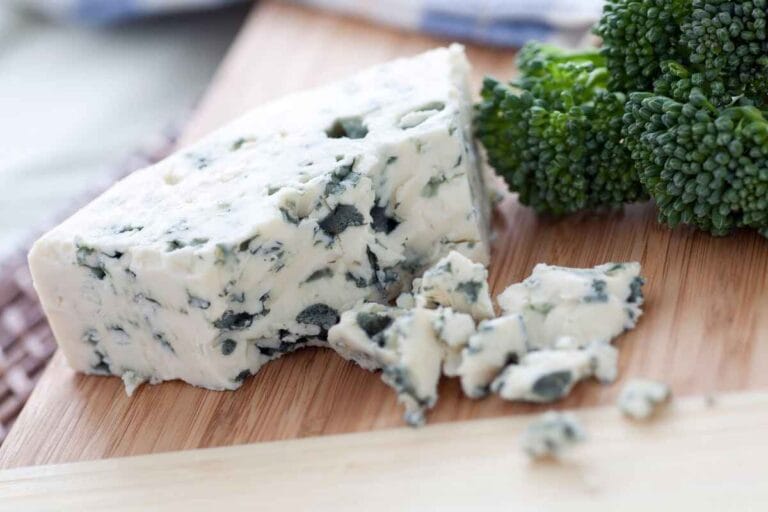Discover everything about blue cheese: its origins, types, health benefits, and culinary uses, including an irresistible Four-Cheese Pizza recipe!
Did you know blue cheese has been a culinary treasure for centuries, beloved for its bold flavor and creamy texture? Let’s dive into the fascinating world of this moldy marvel! 🧀
Table of Contents
What Makes This Cheese Unique?
This particular type of cheese is crafted using specific cultures of Penicillium, which give it the iconic streaks of blue or green mold along with its unmistakable tangy flavor. While its appearance might seem unconventional, its complex taste profile is nothing short of extraordinary—an experience worth savoring.
The Story Behind This Tangy Cheese
The origin of this mold-ripened delicacy is steeped in legend. As the story goes, a shepherd once abandoned his bread and cheese in a damp cave, returning days later to discover the cheese had undergone a remarkable transformation. The cave’s cool, humid environment turned out to be perfect for mold growth, giving rise to what we now know as this bold, flavorful cheese.
Archaeological and historical accounts trace varieties like French Roquefort and Italian Gorgonzola back more than a millennium. Every region that produces this type of cheese infuses its own cultural touch, resulting in an impressive diversity of flavors, textures, and aromas to enjoy.
How is This Unique Cheese Crafted?
Creating this bold-flavored cheese is a blend of science and artistry. The process begins with milk—typically from cows, sheep, or goats—that has been pasteurized to ensure quality. Cheesemakers add a starter culture to the milk to kickstart fermentation, followed by curdling agents like rennet.
Here’s where the magic happens: after the curds are formed, Penicillium spores and salt are incorporated to develop the cheese’s signature flavor. The cheese is then pierced with thin needles, introducing tiny air pockets that encourage mold growth and form those iconic marbled veins.
The aging process is a labor of love. Depending on the variety, this delicacy is aged for weeks or even months in controlled environments, allowing its bold flavors to fully develop. This meticulous process transforms simple ingredients into a rich, flavorful masterpiece. Patience, as any cheesemaker will tell you, is the secret ingredient! 😊
Let me know if further refinements are needed!
Is This Cheese Healthy?
Absolutely! This type of cheese offers surprising health benefits that make it a worthwhile addition to your diet—when enjoyed in moderation, of course. Let’s break it down:
Rich in Calcium and Protein
This cheese is an excellent source of calcium, vital for strong bones and teeth. Just a small serving can provide a significant portion of your daily recommended intake. It’s also packed with protein, which helps repair tissues and build muscle.
Loaded with Probiotics
Thanks to the fermentation process, this mold-ripened cheese is a natural source of probiotics. These beneficial bacteria support gut health by balancing your digestive system and boosting your immunity.
Low in Lactose
For those with lactose sensitivity, this cheese can often be a better option than other dairy products. The fermentation process breaks down most of the lactose, making it easier to digest for many people.
Rich Flavor, Small Portion
One of the best aspects of this cheese is its bold flavor. A little goes a long way, which helps with portion control. This means you can enjoy its rich taste without consuming excessive calories.
Nutrition Facts (Per 30g Serving)
| Nutrient | Amount |
|---|---|
| Calories | 100 |
| Protein | 6g |
| Total Fat | 8g |
| Calcium | 150mg |
| Sodium | 395mg |
While this cheese is nutrient-dense, it’s worth noting that it’s also high in sodium and saturated fats. Enjoy it as part of a balanced diet to reap the benefits without overdoing it.
Blue Cheese in Culinary Creations
If you’re wondering how to make the most of blue cheese, look no further. Its versatility in the kitchen is unmatched, from salads to sauces and even pizzas.
Blue Cheese Pairings: Wine, Fruits, and Nuts
Blue cheese pairs wonderfully with bold red wines or sweet whites like Sauternes. Fruits like pears, figs, and apples complement its saltiness, while nuts such as walnuts and almonds add a delightful crunch. 🍐

How to Make the Perfect Four-Cheese Pizza with Blue Cheese
Craving something indulgent? Let’s whip up a pizza that’s oozing with cheesy goodness.
Ingredients
| Ingredient | Quantity |
|---|---|
| Pizza Dough | 1 ball |
| Mozzarella Cheese | 100g |
| Blue Cheese | 50g |
| Parmesan Cheese | 30g |
| Goat Cheese | 50g |
| Olive Oil | 1 tbsp |
| Fresh Basil (optional) | Handful |
Instructions
- Preheat your oven to 250°C (482°F).
- Roll out the pizza dough on a floured surface and transfer it to a baking tray or pizza stone.
- Drizzle olive oil over the dough, spreading it evenly with a brush.
- Sprinkle the mozzarella, blue cheese, Parmesan, and goat cheese evenly across the base.
- Bake in the oven for 8–12 minutes, or until the crust is golden and the cheese is bubbling.
- Garnish with fresh basil leaves, slice, and serve hot.
Pro tip: For extra flavor, drizzle some honey over the pizza before serving. It might sound odd, but trust me—it’s a game-changer! 🍕
Storing and Preserving
Blue cheese is delicate and needs proper care to maintain its flavor and texture. But don’t worry—storing it isn’t rocket science. A little attention goes a long way to keeping your cheese fresh and tasty!
Ideal Storage Conditions
To preserve the quality of blue cheese, always store it in the refrigerator at a temperature between 4°C and 7°C (39°F to 45°F). Wrap it in wax paper or parchment paper first, then place it in an airtight container to prevent it from drying out or absorbing other flavors in the fridge.
Tip: Avoid using plastic wrap directly, as it can trap moisture and lead to mold overgrowth.
How to Extend Shelf Life Without Compromising Quality
If you’ve bought more blue cheese than you can use, you can freeze it. Yes, freezing blue cheese is possible! While it may slightly alter the texture, the flavor remains intact. Wrap it tightly in aluminum foil and store it in a freezer-safe bag. Use it within three months for the best results.
The Art of Tasting Blue Cheese
Tasting blue cheese is a sensory experience. Like a fine wine, it deserves to be savored and appreciated for its nuances.
Developing a Palate for Blue Cheese
Not everyone loves blue cheese at first bite, and that’s okay. Start with milder varieties like Gorgonzola Dolce before graduating to stronger cheeses like Roquefort. Pair it with a sweet fruit or honey to balance the bold flavors.
Common Mistakes When Sampling Blue Cheese
One common mistake is tasting blue cheese when it’s too cold. Allow it to sit at room temperature for about 30 minutes before serving. This enhances its aroma and flavor profile. Also, avoid overloading your palate—sample smaller pieces to appreciate the complexity.
How to Make Blue Cheese at Home
Feeling adventurous? Making blue cheese at home can be a rewarding project. With a bit of patience and the right tools, you can create your own batch of this flavorful delicacy.
Equipment and Ingredients Needed
| Item | Description |
|---|---|
| Milk | Pasteurized cow’s, goat’s, or sheep’s milk (1 gallon) |
| Starter Culture | Mesophilic starter culture for cheesemaking |
| Blue Mold Spores | Penicillium Roqueforti spores |
| Rennet | Liquid or tablet form for curdling milk |
| Salt | Non-iodized cheese salt |
| Cheesecloth | For draining whey |
| Needle | To create air pockets for mold growth |
Step-by-Step Process for Homemade Blue Cheese
- Heat the milk to 30°C (86°F) in a large pot.
- Add the starter culture and blue mold spores, then let the milk ripen for about an hour.
- Stir in rennet and let the milk set until it forms a firm curd.
- Cut the curd into small cubes and allow it to rest for 5–10 minutes.
- Drain the whey using a cheesecloth and mold the curd into a cheese form.
- Salt the cheese surface generously and allow it to age in a cool, humid environment (about 10°C or 50°F) for several weeks.
- Every few days, pierce the cheese with a sterilized needle to allow air circulation and mold development.
Voila! You’ve just made your first batch of blue cheese. Enjoy the fruits of your labor with a glass of wine or on a warm slice of bread. 🍞🍷
Frequently Asked Questions
Is Blue Cheese Safe to Eat During Pregnancy?
Pregnant women should avoid unpasteurized blue cheese due to the risk of Listeria. However, pasteurized varieties are generally considered safe when consumed in moderation.
Why Does Blue Cheese Have a Strong Smell?
The intense aroma comes from the breakdown of proteins and fats during the aging process. Love it or hate it, that smell is a hallmark of its bold character!
How Long Can Blue Cheese Be Stored?
When stored properly in the fridge, blue cheese can last up to three weeks. If frozen, it can be kept for three months without significant flavor loss.
Can I Eat Blue Cheese If I’m Lactose Intolerant?
Good news! Blue cheese contains very low levels of lactose due to fermentation, making it tolerable for many people with lactose sensitivity. Always consult your doctor, though!
What Makes Blue Cheese Blue?
The blue veins are caused by the introduction of Penicillium mold, which grows in the air pockets inside the cheese during aging. This gives the cheese its signature appearance and taste.
Can I Cook with Blue Cheese?
Absolutely! Blue cheese melts beautifully, making it a fantastic addition to sauces, pastas, and, of course, pizza. It adds a creamy and tangy kick to any dish.
Blue Cheese Around the World
From French Roquefort to British Stilton, blue cheese has left its mark on cuisines worldwide. Each region brings its unique flair to the table, creating a diverse palette of flavors and textures.
Regional Variations and Their Unique Characteristics
French Roquefort is sharp and tangy, while Italian Gorgonzola offers a creamier, milder profile. In Denmark, Danablu is a slightly milder, crumbly version of blue cheese. Each type reflects the traditions and terroir of its origin, much like wine.
The Cultural Significance of Blue Cheese
Blue cheese is more than just food; it’s a symbol of heritage. For example, Roquefort has been protected under French law since the 15th century, underscoring its cultural importance. Isn’t it fascinating how food connects us to history?

